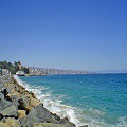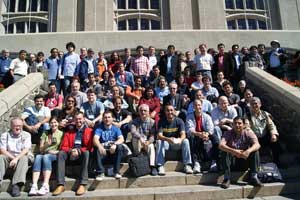The VIII Latin American Symposium on High Energy Physics, Valparaiso, Chile, December 6-12, 2010
Marleigh Sheaff

The Simposio Latinoamericana de Fisica de Alta Energia, or SILAFAE, is the premier event in high energy physics in Latin America. It is held every two years, is organized by Latin American physicists, and takes place in one of the Latin America countries on a rotating basis. The most recent one was held this past December at the Universidad Federico Santa Maria in Valparaiso, Chile. Claudio Dib and his colleagues from Chile did an admirable job of organizing this meeting.
The participants were presented with an excellent program of seminars on a wide variety of topics. Plenary sessions were held in the morning and early afternoon. Two parallel sessions containing shorter, more specialized talks divided into subjects relevant to non-overlapping interest groups followed each afternoon. Wednesday afternoon was left open to allow the participants time to tour this most interesting port city. There was much interest in doing this, since Valparaiso has been designated a World Heritage Site by UNESCO.

The variety of topics covered in the presentations was outstanding. The latest results from the four LHC experiments made it clear that all four are already working well, and very exciting new physics can be expected just around the corner. Other talks covered the latest results from a diverse group of experiments in neutrino physics and cosmology. Since there are a number of prominent theoretical particle physicists and phenomenologists working in Latin America, many of the talks covered their recent research in these areas. A good number of the experimental talks were also presented by Latin American physicists, many of whom work on the forefront experiments of today.
A special program of talks was presented by Fermilab physicists on Friday morning. Young-Kee Kim, Deputy Director of Fermilab, gave an excellent talk on current activities at the lab and welcomed the participants to take advantage of the many opportunities the lab offers to visitors at all stages of their careers. Marcela Carena listed the theorists working at the lab and their current interests. This served as an introduction to details of a special program for Latin American theory graduate students that she initiated at the lab whereby qualified students from an institution in Latin America are supported for a six-month stay at the lab during which they are able to work with anyone in the Fermilab theory department. These talks were followed by three others on experimental opportunities: on the Energy Frontier, given by Jacobo Konigsberg of CDF; on the Intensity Frontier, given by Jorge Morfin of MINERvA; and on the Cosmic Frontier, given by Juan Estrada of the Dark Energy Survey.
At a meeting of the SILAFAE Scientific Committee held during the event in Chile it was decided to hold the next SILAFAE two years from now in Brazil. Rogerio Rosenfeld of the Institute of Theoretical Physics in San Paulo will be the main organizer. Rosenfeld presented some exciting news at this meeting. ICTP, which has its main offices in Trieste, Italy, will operate a branch office at his institution in Brazil. This decision is a clear recognition of the important role Latin American physicists play in the field of high energy physics. More details are available on their web site: http://www.fis.utfsm.cl/silafae2010/
Marleigh Sheaff is a Senior Scientist Emeritus in the Physics Department at the University of Wisconsin.
Disclaimer - The articles and opinion pieces found in this issue of the APS Forum on International Physics Newsletter are not peer refereed and represent solely the views of the authors and not necessarily the views of the APS
